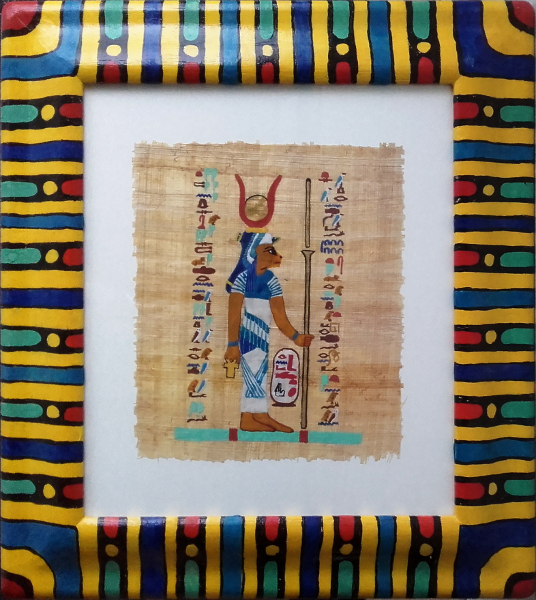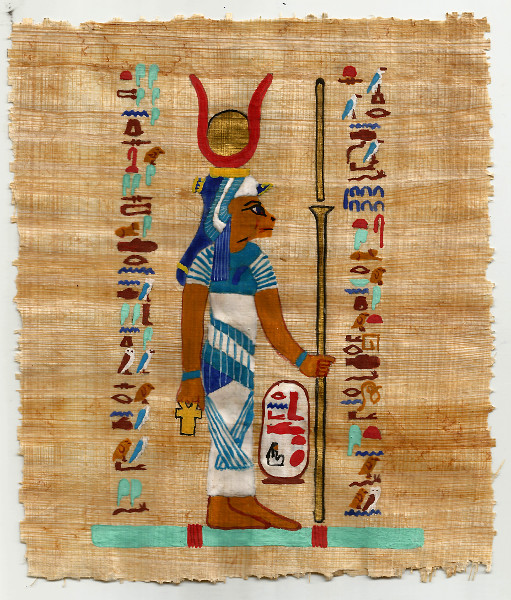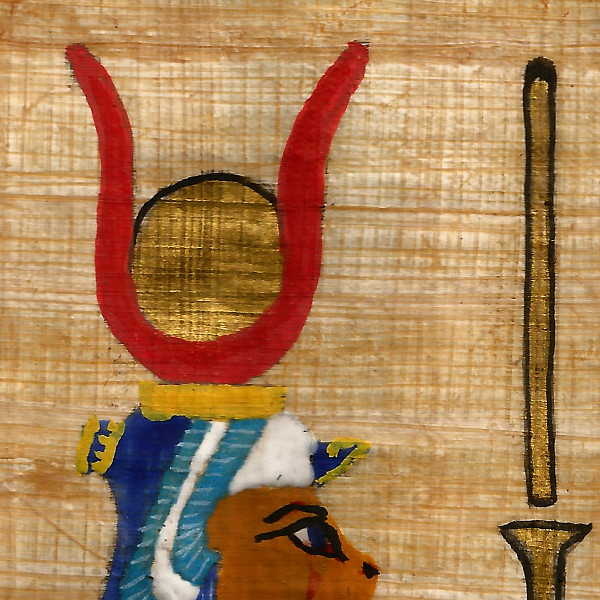Here are some photographs of the details of 'Bernadette at 61' - Hover the mouse over the image to see the text details or
click here to go to the paintings stats page.
 I thought that it would be nice this year to have genuine pigments and shell gold on real papyrus so here we are.
I thought that it would be nice this year to have genuine pigments and shell gold on real papyrus so here we are.
The frame is a bare wood blank moulding that has been underpinned then sized with acacia resin then painted with early colour pigment watercolours.
The colours in the frame are as follows:
- Cinnabar
- Orpiment
- Egyptian Blue
- Malachite
- Lamp Black
- Lapis Lazuli
Cinnabar is what the Egyptians used, not vermilion. Vermilion is the human made/refined version of the colour but actual cinnabar is a very good colour anyway.
Apparently vermilion is being passed off as cinnabar by some unscrupulous suppliers so my supplier sends the coarsely ground, granular cinnabar instead so that we
can tell that it is the real thing. It grinds well on the slab under the muller and hand made old pigments are coarser than modern synthetic or machine-made pigments
any way so it adds to the genuine look.
Orpiment is Arsenic Sulphide and comes from a mineral that is ground down into a powder for use as a pigment. This has very good covering power.
Egyptian Blue was the first synthetic pigment and variations in the bolour between a greenish blue and a blueish green occur according to the ration of
copper to calcium
Malachite is ground up copper ore making an attractive blueish green and during the bronze age there had to be a good supply of this.
Lamp black was scraped off lamps as soot and is common to many civilisations, the other black that the Egyptians used being bone black.
This is genuine lapis lazuli - the natural version of the synthetic pigment french ultramarine. There is a laborious process for removing the unwanted minerals
from inferior selections of natural lapis lazuli, involving gums and so on but if you start off with the good stuff, you don't need to do that.
 The actual painting uses the above pigments but also uses:
The actual painting uses the above pigments but also uses:
- Shell gold
- Red ochre
- Yellow ochre
- Lead white
- Chalk white
The shell gold is 23kt dukat gold ground down into a very fine powder and despite its cost, does go a long way.
Like the other pigments used here,
the gold is in an acacia-based medium and is painted on like any other watercolour - although you tend to be a bit more aware of any potential waste
of the colour.
Once it has dried, you then use an agate burnisher to rub it until the gold on the surface of the paint is effectively smeared over
the surface and, because gold does not form an oxide surface, welded into a fairly continuous layer so it reflects light as though it had been
applied as gold leaf.
For the reason that you can paint it wherever you like with a paint brush such as a '10-0', you can apply it more accurately
than gold leaf. Another advantage is that the shell gold paint can be left without burnishing it to leave a more diffuse surface, reflecting light from a wider angle.
 This is a close-up of the papyrus itself. You can see that it is made from thinly sliced plant stems that have been laid
down in two layers - one vertically and the other horizontally.
This is a close-up of the papyrus itself. You can see that it is made from thinly sliced plant stems that have been laid
down in two layers - one vertically and the other horizontally.
To give you in idea of the scale of this material, the area you can see is approximately 5cmx5cm (2"x2")
The papyrus is supplied with the edges cut neatly so, to create an older look, I've just broken the edge away slightly. One that to note is that it is quite strong and
tears along the grain so you have to be careful when doing this.
 Here, you can see the shell gold and how it reflects light when on the surface of the papyrus.
Here, you can see the shell gold and how it reflects light when on the surface of the papyrus.
All images and original artwork Copyright ©2019 Paul Alan Grosse.